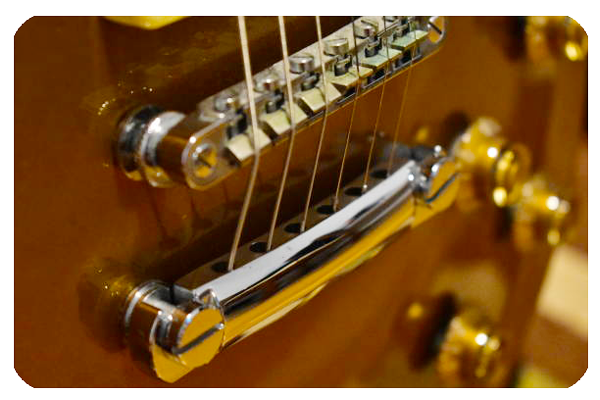A step by step tutorial that breaks down how to change out the string gauge on a “Gibson style” fixed bridge guitar – including how to set the intonation for the new gauge. Learn how to; change strings, set the bridge saddles, and adjust the intonation sharp or flat. The lesson is both easy and informative for any level guitarist.
Fixed Bridge Intonation Diagnosis:
If you begin to notice that your mid-neck chords sound slightly out of tune, or that some notes which are performed up high on the neck start to sound slightly out of pitch, you might have an intonation problem.
Sometimes you will also notice a few ‘out of tune notes’ while you’re practicing your favorite solos. But, no matter how much you try and tune your guitar those out of tune notes just won’t go away.
If this happens, you might very well have an intonation issue. The notes on every guitar string must be equal to their fret location along with their natural scale temperament.
In order to set the intonation of a guitar you’ll need a well calibrated electronic guitar tuner. The tuners will guide your ear so that together your guitar intonation may be properly corrected.
After installing and properly tuning up a new set of guitar strings to standard pitch (with the tuner), conduct a quick check over of your guitars action (string height). Make sure the string height is well balanced across the arc of the fingerboard radius.
Adjust the action to how you like it and do any other simple repairs at this time as well, (such as fixing any loose parts, string buzz, or fret buzz problems you might have).
The Fixed Bridge:

Fixed bridges are screwed into the body of the guitar and keep the guitar strings in place resting on saddles. Some fixed bridge designs are two piece units (as shown above), with the saddle unit separated from the bridge unit.
Each string end runs from the body bridge unit(s) up past the nut, into the head-stock machine-head tuners. Strings come standard with ball ends, so naturally, the fixed bridge will accommodate their functionality.
Setting Intonation:
With your tuner turned on, and the open string confirmed as being, “in tune,” fret and check the note at the guitars first string, 12th fret to be sure it is also in tune.
You will need to be quite careful here. Pressing or picking too hard will alter the accuracy of this test. Use a light amount of pressure during this test.
If, according to the tuner, the fretted note at the 12th fret is too high (sharp), or too low (flat), an adjustment will need to be performed to bring the note into proper pitch range.
If the note is SHARP, you will need to move the saddle AWAY from the fingerboard. If the note is FLAT, move the saddle TOWARD the fingerboard. These adjustments will be made to the saddle screws.
After making the adjustments, check the notes again. You may need to repeat this process over and over until the 12th fret note is as accurate as possible in relation to the tuning of the guitar’s open string.

NOTE: Bridges which are fixed might look quite different from guitar to guitar, (see image above of a string through body fixed bridge design).
However, no matter how a fixed bridge is engineered, you’ll want to keep in mind that the fixed bridge set-up will never have any sort of a whammy /vibrato bar system incorporated into it’s design functionality.
Completing the Intonation Adjustment:
Work through all of the guitar strings, repeating the process until your intonation adjustments for each string are complete.
Keep in mind that it is always a good idea to have a fixed pitch reference instrument, (such as an electronic keyboard, or you could use the internet based, “Online Piano“), to compare all of the notes on each string.
Continue to tune and adjust the saddles until every guitar string rings out as true to pitch as possible. After you feel satisfied with your adjustments, play a few barre chords, and try a guitar solo or two, to hear how true the fretted notes are ringing to pitch.
